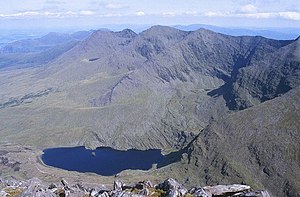Knocknapeasta
| Knocknapeasta | |||
| County Kerry | |||
|---|---|---|---|
 Knocknapeasta and part of Loch Coimín Piast (top left) | |||
| Range: | MacGillycuddy's Reeks | ||
| Summit: | 3,241 feet V835841 | ||
Knocknapeasta, sometimes called Slievenapeesta or Cummeennapeasta,[1] is mountain in County Kerry, within Ireland's highest mountain range; MacGillycuddy's Reeks. It reaches 3,241 feet and is the fourth-highest summit in Ireland, bested only by Carrauntoohil, Beenkeragh and Caher, all within the same range.
The name Knocknapeasta is from the Irish language, in which it is called Cnoc na Péiste, meaning "Hill of the Serpent".
Setting
Knocknapeasta is the highest point on a ridge heading east from Carrauntoohil towards Purple Mountain, from which it is separated by the Gap of Dunloe. To the southwest of Knocknapeasta is the peak of Maolán Buí (3,192 feet)[2] and to the northeast is The Big Gun (3,081 feet).
Between Knocknapeasta and The Big Gun there are two small lakes named Lough Cummeenapeasta and Lough Googh, one on either side of the ridge. A stream called Glasheencummeennapeasta flows northwards from Lough Cummeenapeasta into Hag's Glen, where it joins the Gaddagh River. On the other side of the ridge, a stream flows southwards from Lough Googh into the Derrycarna River.
Ascent
Climbers and walkers tend to tackle all the MacGillycuddy's Reeks in a single attempt, often from the northeast along the Hag's Glen, since there are few other options for descent from the main ridge.[3] The continuation of the ridge east of Knocknapeasta is very sharp and cannot be walked; hikers must take a route to one side of the ridge to continue on to The Big Gun.
Aircraft crash
On 17 December 1943, at about 7 am, a United States Army Air Forces Douglas C-47 Dakota crashed into the side of Knocknapeasta.[4][5] This was during the Second World War, notwithstanding the Irish Free State's neutrality. It struck the mountain just above Lough Cummeenapeasta at an altitude of about 2,000 ft, killing all five crewmen.[5] The Gardaí were not alerted to the crash until 3 February 1944, and the following day an Irish Army detachment was sent to recover the bodies.[5] Pieces of the aircraft can still be seen on the mountainside, and a plaque was placed at the shore of the lake to commemorate the victims.[4][5]
References
- ↑ E. D. "Clem" Clements (1997). The Hewitts and Marilyns of Ireland. TACit Press. ISBN 0-9522680-8-6.
- ↑ MountainViews - Maolán Buí
- ↑ Dillon, Paddy (1998). Exploring the South of Ireland. Ward Lock. ISBN 0-7063-7566-1.
- ↑ 4.0 4.1 MountainViews
- ↑ 5.0 5.1 5.2 5.3 Warplane Research Group of Ireland